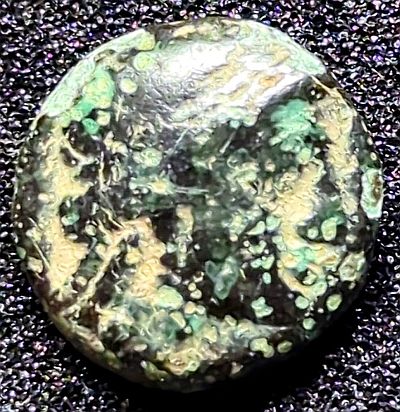A relaxing ancient coin, with minimal information

As I post this, it is the week between Christmas and New Year, the “in-between” time the Norwegians call “Romjul”. What better time to write up a coin depicting someone relaxing.
Thrace
Ancient Thrace was comprised of many different tribes and kingdoms throughout the Balkan region of modern-day Bulgaria, Greece, and Turkey. Macedon/Macedonia once took control of many Thracian lands during the reign of Philip II circa 360 B.C., which lasted until the end of the Macedonian Wars (214-148 B.C.) when Rome gained control over much of Thrace.
Odessos, where this coin was issued, is now known as Varna, a town on the eastern coast of present-day Bulgaria. Lake Varna stretches west from the town, and joins with Lake Beloslav. This type of enlarged estury is called a Liman. When the Greeks founded Odessos, they named it in honour of Homer’s Odysseus.
Reverse
Wildwinds describes the seated figure as “River God reclining left, holding amphora”. I’ve written about river gods before, from Gela in Italy. Unfortunately I haven’t found more about WHO this river God was. If you know, please do comment below. Either way, the figure is relaxing, and that was my thought when I started this piece!
Some sources such as Numista, credit the figure as being Odysseus, the hero of Homer’s Odyssey. The Romans transformed the name to Ulysses, which is how he is more commonly known today.
Obverse

I’m not sure who is depicted on the obverse. Both Numista and Wildwinds agree it is a “Female head right, hair bound in a taenia”, but offer little further information. So, I’ll grab the one snippet there I didn’t already know, and share it in case you also didn’t know what a taenia was. Basically, it’s just a ribbon, worn as a headband, with traditional dress at festivals. Gods were also often depicted wearing them. While coins often depict Gods, even assuming this is a female, ancient Greek god doesn’t help, as there were many. GreekGodsAndGodesses.net lists over 80. If we go with the Odysseus reclining image on the reverse and suppose the Goddess is one mentioned in the Odyssey, there are still a number of contenders. Athena, Calypso, Circe are all major Goddesses in the story. Ino was a minor goddess, and I’ve likely missed others.
The time period on this coin is a little vague, again because of discrepencies between sources. Numista lists 250 – 200 BC. Wildwinds notes 4th Century BC (300 – 400). I can find other *similar* coins but none which look convincingly the same. Further down on that same Wildwinds page is a piece (recorded as “Moushmov 1529.1”) described as:
“Thrace, Odessos. ca 270-250 BC. AE17.
Obv: Laureate head of Apollo right
Rev: The Great God reclining left on plinth inscribed ODHSITWN, holding patera in right hand,
cornucopiae in left, inverted amphora in left field,
monogram above.”
There are three others below that ranging from 270 – 250 BC to “After 200 BC”, although all look slightly different to mine (and the first one on that page).
Double checking attributions
A quick aside for a reminder on double checking information. I had this coin attributed to the town of Maroneia. With the reclining figure as Odysseus (per Numista), this all linked in well with Homer’s Odyssey where Maron, the priest, gave Odysseus a gift of wine. What I had done was incorrectly copy the town from the previous coin I had recorded in my collection, which was from that Maroneia.
I noticed before I posted this, so could have simply corrected it and not said anything. But, it is easy for mistakes like that to occur, so I thought it was worth sharing my embarrassment in order to give you the reminder to always double check information.
So what was the coin from Maroneia? It was an AE 14, also from Thrace (~400 – 350BC), similar to this piece on Numista.

So, an accidental misattribution led to an interesting exploration of Homer’s Odyssey, on a coin which may have nothing to do with the work. Numismatics can be a fun rabbit hole at times! What is your most interesting misattribution? Let us know below!


Leave a Reply